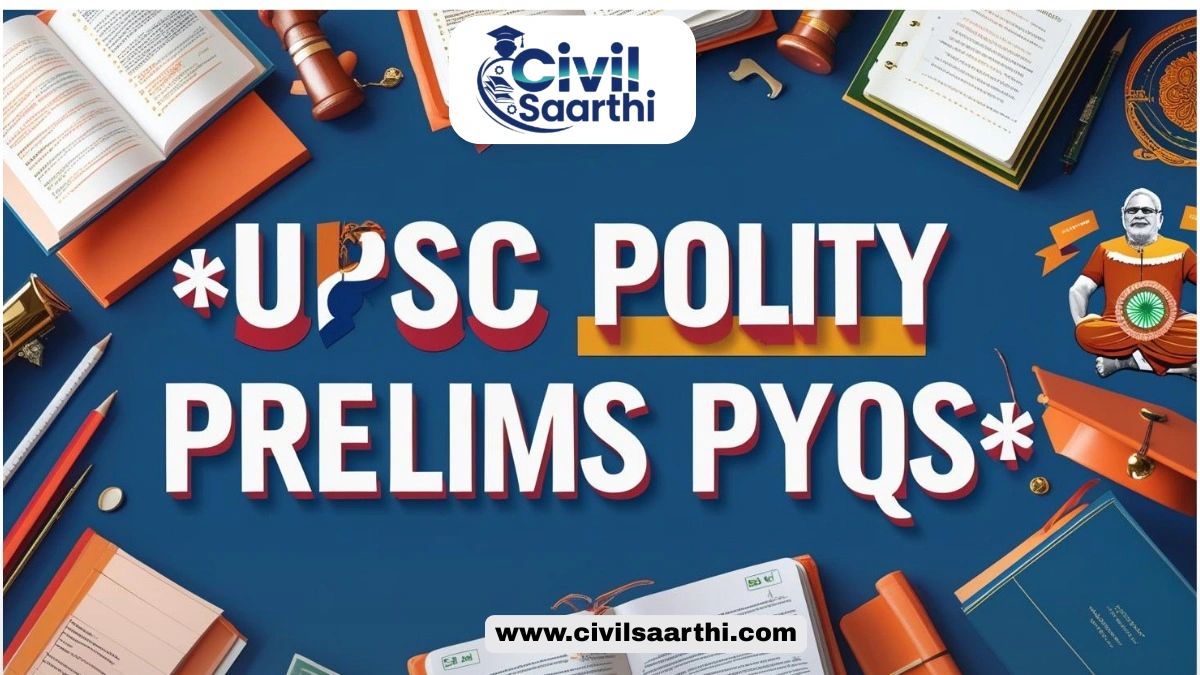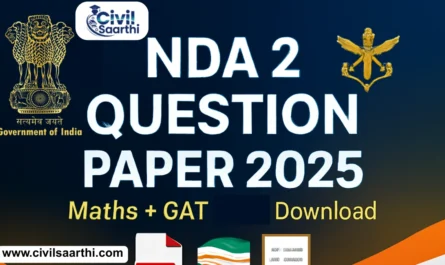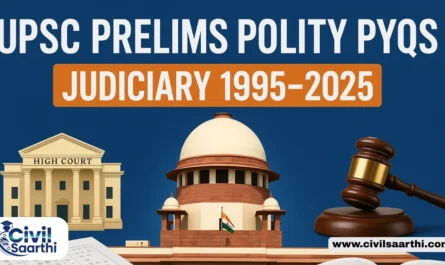This section provides a comprehensive collection of UPSC Prelims polity questions focused on the constitutional roles of the President, Vice President, and Governors from 2025 to 1995. It includes questions based on their powers, functions, election process, removal mechanisms, and recent amendments or judgments. Practicing these topic-wise PYQs helps aspirants understand the pattern, difficulty level, and frequently asked areas in the exam. These questions are crucial for mastering Indian Polity under the constitutional framework.
UPSC Prelims Polity Topic-wise PYQs on President, Vice President and Governor (2025-1995)
Q1. Consider the following statements: [2024]
- It is the Governor of the State who recognizes and declares any community of that State as a Scheduled Tribe.
- A community declared as a Scheduled Tribe in a State need not be so in another State.
Which of the statements given above is/are correct?
a) 1 only
b) 2 only
c) Both 1 and 2
d) Neither I nor 2
Ans b
Q2. Consider the following statements in respect of election to the President of India: [2023]
- The members nominated to either House of the Parliament or the Legislative Assemblies of States are also eligible to be included in the Electoral College.
- Higher the number of elective Assembly seats, higher is the value of vote of each MLA of that state.
- The value of vote of each MLA of Madhya Pradesh is greater than that of Kerala.
- The value of vote of each MLA of Puducherry is higher than that of Arunachal Pradesh because the ratio of total population to total number of elective seats in Puducherry is greater as compared to Arunachal Pradesh.
How many of the above statements are correct?
a) Only one
b) Only two
c) Only three
d) All four
Ans a
Q3. Consider the following statements: [2023]
- If the election of the President of India
- is declared void by the Supreme Court of India, all acts done by him/her in the performance of duties of his/her office of President before the date of decision become invalid.
- Election for the post of the President of India can be postponed on the ground that some Legislative Assemblies have been dissolved and election are yet to take place.
- When a Bill is presented to the President of India, the Constitution prescribes time limits within which he/she has to declare his/her assent.
How many of the above statements are correct?
a) only one
b) only two
c) All three
d) None
Ans d
Q4. Which one of the following suggested that the Governor should be an eminent person from outside the State and should be a detached figure without intense political links or should not have taken part in politics in the recent past? [2019]
a) First Administrative Reforms Commission (1966)
b) Rajamannar Committee (1969)
c) Sarkaria Commission (1983)
d) National Commission to Review the Working of the Constitution (2000)
Ans c
Q5. Consider the following statements: [2018]
- No criminal proceeding shall be instituted against the Governor of a state in any court during his terms of office.
- The emoluments and allowances of the Governor of a state shall not be diminished during his terms of office.
Which of the statements given above is /are correct?
a) 1 only
b) 2 only
c) Both 1 and 2
d) Neither 1 nor 2
Ans c
Q6. With reference to the election of the President of India, consider the following statements: [2018]
- The value of the vote of each MLA varies from State to State.
- The value of the vote of MPs of the Lok Sabha is more than the value of the vote of MPs of the Rajya Sabha.
Which of the statements given above is/are correct?
(a) 1 only (b) 2 only
(c) Both 1 and 2 (d) Neither 1 nor 2
Ans a
Q7. Which of the following are the discretionary powers given to the Governor of a State? [2014]
- Sending a report to the President of India for imposing the President’s rule Appointing the Ministers
- Reserving certain bills passed by the State Legislature for consideration of the President of India
- Making the rules to conduct the business of the State Government
Select the correct answer using the code given below:
a) 1 and 2 only
b) 1 and 3 only
c) 2, 3 and 4 only
d) 1, 2, 3 and 4
Ans b
Q8. Which one of the following statements is correct? [2013]
a) In India, the same person cannot be appointed as governor for two or more states at the same time
b) The judges of the high court of the states in India are appointed by the Governor of the state just as the judges of the Supreme Court are appointed by the president
c) No procedure has been laid down in the constitution of India for the removal of a governor from his/her post
d) In the case of a union territory having a legislative setup, the chief minister is appointed by the Lt. Governor on the basis of majority support.
Ans c
Q9. To the Constitution of India, it is the duty of the President of India to cause to be laid before the Parliament which of the following? [2012]
- The Recommendations of the Union Finance Commission
- The Report of the Public Accounts Committee
- The Report of the Comptroller and Auditor General
- The Report of the National Commission for Scheduled Castes.
Select the correct answer using the codes given below:
a) 1 Only b) 2 and 4 Only
c) 1, 3 and 4 Only d) 1, 2, 3 and 4
Ans c
Q10. Who of the following shall cause every recommendation made by the Finance Commission to be laid before each House of Parliament? [2010]
a) The President of India
b) The Speaker of Lok Sabha
c) The Prime Minister of India
d) The Union Finance Minister
Ans a
Q11. The following statements: [2009]
- The Governor of Punjab is concurrently the administrator of Chandigarh
- The Governor of Kerala is’ concurrently the administrator of Lakshadweep
Which of the above statements is/ are correct?
a) 1 only
b) 2 only
c) Both 1 and 2
d) None
Ans a
Q12. Who among the following have held the office of the Vice President of India? [2008]
- Mohammad Hidayatullah
- Fakhruddin Ali Ahmed
- Neelam Sanjiva
- Shankar Dayal Sharma
Select the correct answer using the code given below:
a) 1, 2, 3 and 4 b) 1 and 4 only
c) 2 and 3 only d) 3 and 4 only
Ans b
Q13. The resolution for removing the Vice-President of India can be moved in the: [2004]
a) Lok Sabha alone
b) Either House of Parliament
c) Joint Sitting of Parliament
d) Rajya Sabha alone
Ans d
Q14. Consider the following statements: In the electoral college for the Presidential Election in India. [2003]
- The value of the vote of an elected Member of Legislative Assembly equals
- The value of the vote of an elected Member of parliament equals
- There were more than 5000 members in the latest election.
Which of these statements is/are correct?
a) 1 and 2 b) Only 2
c) 1 and 3 d) Only 3
Ans b
Q15. Under which Article of the Indian Constitution did the President give his assent to the ordinance on electoral reforms when it was sent back to him by the Union Cabinet without making any changes (in the year 2002)? [2003]
a) Article 121 b) Article 122
c) Article 123 d) Article 124
Ans c
Q16. Which one of the following amendments to the Indian Constitution empowers the President to send back any matter for reconsideration by the Council of Ministers? [2002]
a) 39th b) 40th
c) 42nd d) 44th
Ans d
Q17. One of the following are/is stated in the Constitution of India? [1997]
I. The President shall not be a member of either House of Parliament.
II. The Parliament shall consist of the President and two Houses.
Choose the correct answer from the codes given below:
a) Neither I nor II
b) Both I and II
c) I alone
d) II alone
Ans b
Q18. The Presidential election in India, every elected member of the Legislative Assembly of a State shall have as many votes as there are multiples of one thousand in the quotient obtained by dividing the population of the State by the total number of the elected members of the Assembly. As at present (1997) the expression “population” here means the population as ascertained by the: [1997]
a) 1991 Census b) 1981 Census
c) 1971 Census d) 1961 Census
Ans c
Q18. Which one of the following is part of the electoral college for the election of the President of India but does not form part of the forum for his impeachment? [1996]
a) Lok Sabha
b) Rajya Sabha
c) State Legislative Councils
d) State Legislative Assemblies
Ans d
Q19. Article 156 of the Constitution of India provides that a Governor shall hold office for a term of five years from the date on which he enters upon his office. Which of the following can be deduced from this? [1995]
I. No Governor can be removed from office till completion of his term.
II. No Governor can continue in office beyond a period of five years.
Select the correct answer from the codes given below:
Codes:
a) I only
b) II only
c) Both I and II
d) Neither I nor II
Ans d



